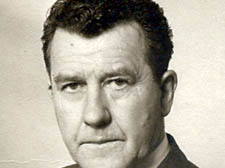|
|
 |
| |

John Murphy |
Builder off the Holyhead boat who rose to become Rich List millionaire
John Murphy, founder of the civil engineering company known by its dark green lorries, has died, as reported last week in the Tribune. Below, Gerry Harrison, historian of the north London Irish community, adds his appraisal of the reclusive millionaire.
THE muddy construction lorries and vans parked in the street, while the “subbies” or “agents” responsible for them were recruiting labour, were once a feature of grim early mornings in north London. Each of the major firms had its pick-up point. For the Murphy brothers, this was near Peter’s Café in Camden Road, Camden Town, where often alongside their vans were battered coaches ready to scoop up men to take them to Murphy sites at Heathrow Airport or the Isle of Grain power station.
Their vehicles were distinctively painted, green or grey. The green vans were those of John Murphy, and the grey ones those of his brother, Joseph. Within the Irish community they soon become known as “the green and the grey”. The Green Murphy’s men tended to work at ground level or above, while those of Joe, the Grey Murphy, worked underground, often in cable-laying or tunnelling. Hence the colours. From depots in Kentish Town and Islington, they employed thousands of men and soon made their mark in brick and concrete on the London scene.
John and his brother Joe were from a large family near Caherciveen in County Kerry. John Murphy, who disembarked from the boat at Holyhead just before the war, was notoriously reclusive in later life, and speculation surrounds his date of birth, which is thought to be 1915.
At the time of his death, he was one of Britain’s wealthiest men, worth £190million, and featured each year near the top of the Sunday Times Rich List. But in 1946, he was an ambitious builder, and was followed to England by his brother, who died a tax exile in Guernsey in 2000.
During the war, John had been contracted to remove obstacles from the English Channel, and his business developed from these small beginnings. After 10 years, he and Joe split and opened separate depots. “Big” John’s survives at Hillview House, off Highgate Road, in Kentish Town, where until late in his life he was one of the first to arrive each morning and was often to be seen sweeping the yard, the sleeves of his ill-fitting suit contrasting with the massive workman’s hands with which he wielded the broom. Inside the office foyer were two beehives, a gift from a Kerry friend, which he kept there as a reminder of swarming industriousness.
In the early years of little or no regulation, the labour they took on was “on the lump”, sometimes hired directly but more cautiously through sub-contractors. Corners were cut. There was a verbal agreement about pay, often by the hour, but nothing signed.
True names were never divulged, so “Eamonn Andrews” was often working on 100 sites in one day. With the anonymity came no tax or National Insurance deductions. But also came no responsibility if a man was injured. When one died his name was sometimes not known. It was a brutal system, where hard work was unappreciated and there was little reward. Certainly little to write home about.
Meanwhile, contracts increased in size. Customers included British Rail, the GLC, cabling for the Post Office, pipelines for North Sea oil and gas companies, and the Channel Tunnel Rail Link. Recently in Camden, the Green Murphy was responsible for renewing the ancient water mains.
A secretive man, John Murphy spent the last years of his life in Greenaway Gardens, Hampstead, where he lived with his second wife, who had been the nurse of his first in her illness. Dancing and golf were his pastimes. Occasionally he ventured to Mass, in particular to the massive Sacred Heart of Jesus Church in Quex Road, Kilburn, where he kept a modest profile.
In spite of this, companies he controlled have international interests in shipping, in hotels and property. His construction companies proliferate, yet mystery always surrounded him, and questions were asked what he did with his personal fortune. He rarely flaunted his wealth; strings of race-horses and private planes were not for him.
There have been donations to charity and other philanthropic gestures, such as his keen involvement in the late 1970s in the building of major extensions to the London Irish Centre in Camden Town.
|
 |
|
|
 |
|
| |
| |
|
 |
|